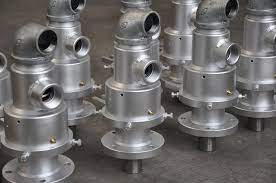Troubleshooting and maintenance of rotary joints in industrial plants
Troubleshooting and maintenance of rotary joints in industrial plants
Rotary joints are used in different industries. It has the ability to stop the entire production within seconds make sure you know all about troubleshooting and maintenance
Troubleshooting rotary joints involves identifying and addressing issues related to fluid leakage, signal interruptions, wear, or other performance problems. Here are some common troubleshooting steps for rotary joints:

- Fluid Leakage:
- Inspect Seals and Gaskets: Check for wear, damage, or misalignment of seals and gaskets. Replace any components that show signs of deterioration.
- Tighten Connections: Ensure that all connections are properly tightened to prevent leaks.
- Verify Fluid Compatibility: Confirm that the fluid being transferred is compatible with the materials used in the rotary joint. Incompatibility can lead to seal degradation.
- Signal Interruptions (Electrical Rotary Joints):
- Check Electrical Connections: Ensure that electrical connections are secure and free from corrosion. Clean or replace connectors if necessary.
- Inspect Brushes and Rings: For slip rings, inspect the brushes and rings for wear. Clean or replace them if worn out.
- Check Wiring: Inspect the wiring for breaks, loose connections, or damage. Repair or replace as needed.
- Excessive Wear:
- Inspect Bearing Surfaces: Examine bearing surfaces for wear or damage. Replace bearings if they show signs of deterioration.
- Check Lubrication: Ensure proper lubrication of moving parts. Insufficient lubrication can lead to increased wear. Follow manufacturer recommendations for lubrication intervals.
- Noisy Operation:
- Inspect Bearings: Noisy operation can be a result of worn or damaged bearings. Replace bearings if necessary.
- Check Misalignment: Ensure that the rotary joint is properly aligned. Misalignment can cause excessive friction and noise.
- Reduced Rotational Speed:
- Inspect for Binding: Check for any obstructions or binding that may be impeding the rotation. Clear any debris or correct misalignments.
- Check for Lubrication Issues: Insufficient lubrication can lead to increased friction and reduced rotational speed. Verify that the lubrication system is functioning correctly.
- Temperature Issues:
- Check for Overheating: Overheating can be caused by excessive friction or inadequate cooling. Inspect the cooling system and ensure proper lubrication.
- Verify Operating Conditions: Ensure that the rotary joint is operating within the specified temperature range. Extreme temperatures can affect performance.
- Electromagnetic Interference (EMI):
- Inspect Shielding: For electrical rotary joints, check for proper shielding to minimize electromagnetic interference. Ensure that cables are properly grounded.
- Corrosion and Contamination:
- Inspect for Corrosion: Check for corrosion on metal components. Replace or treat corroded parts as needed.
- Prevent Contamination: In environments with dust or other contaminants, take measures to minimize the entry of foreign particles into the rotary joint.
Always refer to the manufacturer's guidelines and specifications for maintenance and troubleshooting. If issues persist or if you are unsure about the diagnosis, it may be advisable to consult with the manufacturer or a qualified technician for further assistance.
Contact us to safeguard Cell: +91-8433777035 or Email: info@sealomech.com

